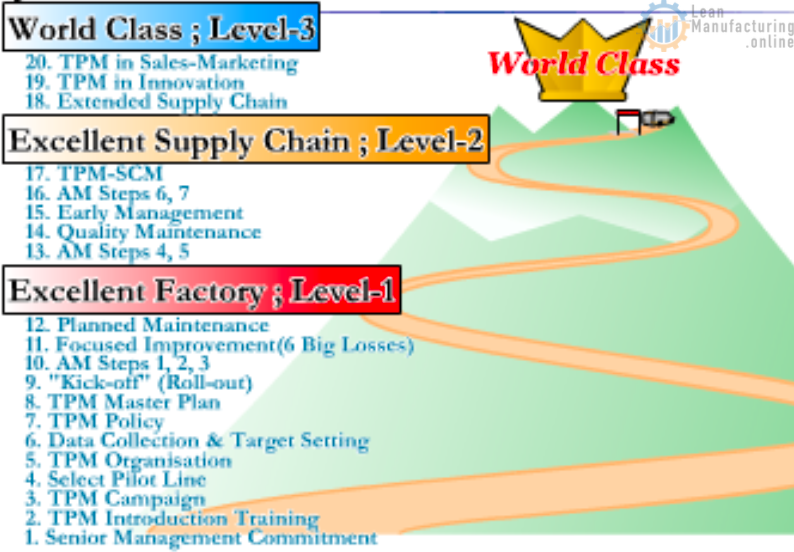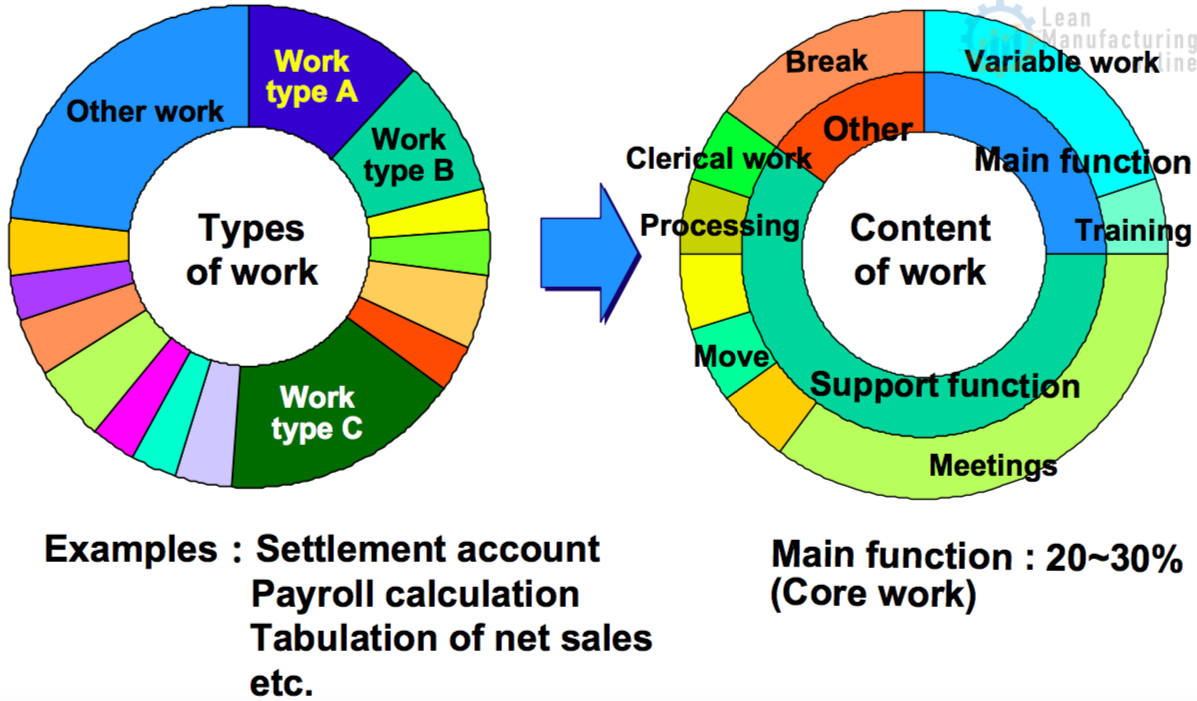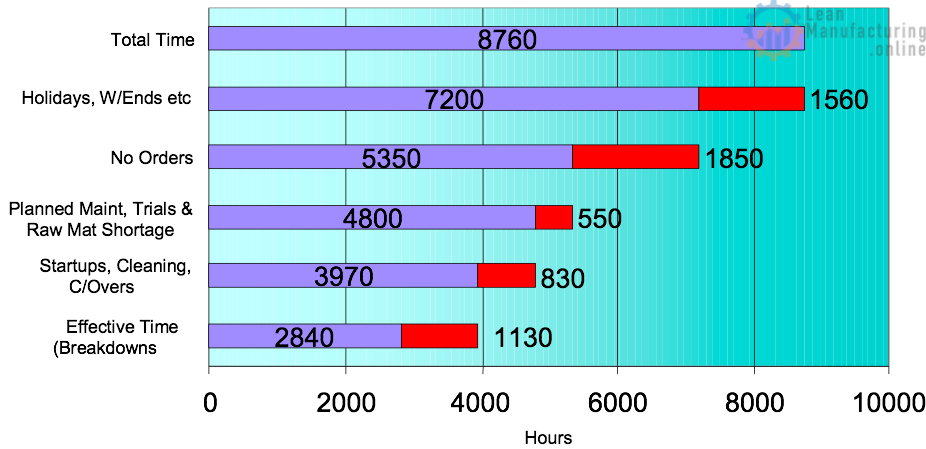1. The Need for TPM in Administrative and Support Departments
1.1 Why TPM is Needed – the Background
Modern advances in computer and communications technology have created a world in which all kinds of information can be exchanged in real-time all over the globe. This has given added impetus to the diversification of consumer requirements and rapid lifestyle changes taking place in today’s society. An increasing variety of unique products, each with a very short life-cycle, has emerged to meet these demands, making the job of running a business more complicated than ever. In these changing circumstances, the top priority for many companies is to build systems that will allow them to survive and prosper in the face of fierce domestic and overseas competition. All organizations need their own clearly defined business strategy for responding to market trends. Apart from the obvious need to develop new products and bring them to market as quickly as possible, another vital issue for managers is to mark their company out from its rivals in terms of both quality and cost.
It is reckoned that eighty percent of a product’s quality and the cost is built into it during its development, design, and manufacture. This means that the development, design, and other relevant departments must work closely with the production department, providing comprehensive backup to eliminate any waste during production. The production department, meanwhile, needs a system that allows it to make the products ordered by the sales department, on time, and at the levels of quality and cost expected by the development and technology departments. This requires a TPM program that embraces not just the production department but the entire company, including administrative and support departments.
But if administrative and support staff do not work directly with production equipment, how can they practice TPM? To do this properly, they must do more than just increase the productivity of their own work by reducing waste and errors and creating procedural manuals for their administrative systems. They must also achieve tangible results that make a real contribution to the business, helping to raise the efficiency of the production system through every facet of the organization’s activities.
1.2 The Role of Administrative and Support Departments
2. Developing Autonomous Maintenance for Administrative Functions
Wide variations in the time it takes to do a job, tasks that have to be redone and documents that have to be rewritten, missed deadlines, jobs that are neglected if the person directly responsible is out of the office, frequent data entry errors, uneven workloads owing to tasks piling up at the end of the day, week or month … such problems are an everyday occurrence in administrative work, but even though they crop up so frequently, they tend to remain unacknowledged.
In production departments, work is controlled down to the last minute or second. Operators are fully aware that any stoppage, however small, creates a loss, and hence they make every effort to eliminate downtime. But in office departments, by contrast, work can be delivered an hour, or even a whole day late, and no-one particularly seems to mind.
In many offices, the work is not standardized, and each individual is allowed to do the task in the way he or she sees fit. Businesses really must become aware of the losses and waste inherent in such ingrained practices, and revamp their administrative setups from top to bottom to increase the value of their administrative work. Companies can sharpen their competitive edge considerably by improving employees’ administrative skills to create a workforce of excellent administrators, and then making full use of those skills.
Because of these requirements, Autonomous Maintenance is just as important in administrative and support departments as it is in the production department (see Table 10.1 and Figure 10.4).
2.1 How Should Autonomous Maintenance be Applied to Administration?
Establish basic conditions for administrative tasks currently performed within the department, and create standards for these tasks after eradicating all losses and irregularities through restoration and improvement.
(1) Basic approach
1 Establish basic conditions for administrative tasks
2 Create a system for processing administrative information efficiently, without any losses or irregularities.
(2) Establishing basic conditions for administrative tasks means:
1 Establishing the right administrative environment (the physical surroundings)
- Eliminate mental and physical stress by creating the best surroundings in which to perform the administrative tasks;
2 Establishing the right administrative functions (the intangible aspects)
- Eradicate all administrative waste, correct any functional deficiencies, and standardize the administrative tasks;
3 Establishing the right administrative skills
- Create a workforce of excellent, multi-skilled administrators capable of acquiring and utilizing expertise in particular fields.
(3) Aims
1) Standardise administrative tasks and maximize their effectiveness (eradicate losses)
2) Raise administrative productivity (specialize, simplify, standardize)
3) Improve customer service (minimize errors, increase the usefulness, improve the speed of response)
4) Respect individuality (eliminate stress and allow specialization, so employees develop a real enthusiasm for their work)
Table 10.1 New Step-by-Step Development of Autonomous Maintenance in Administrative and Support Departments
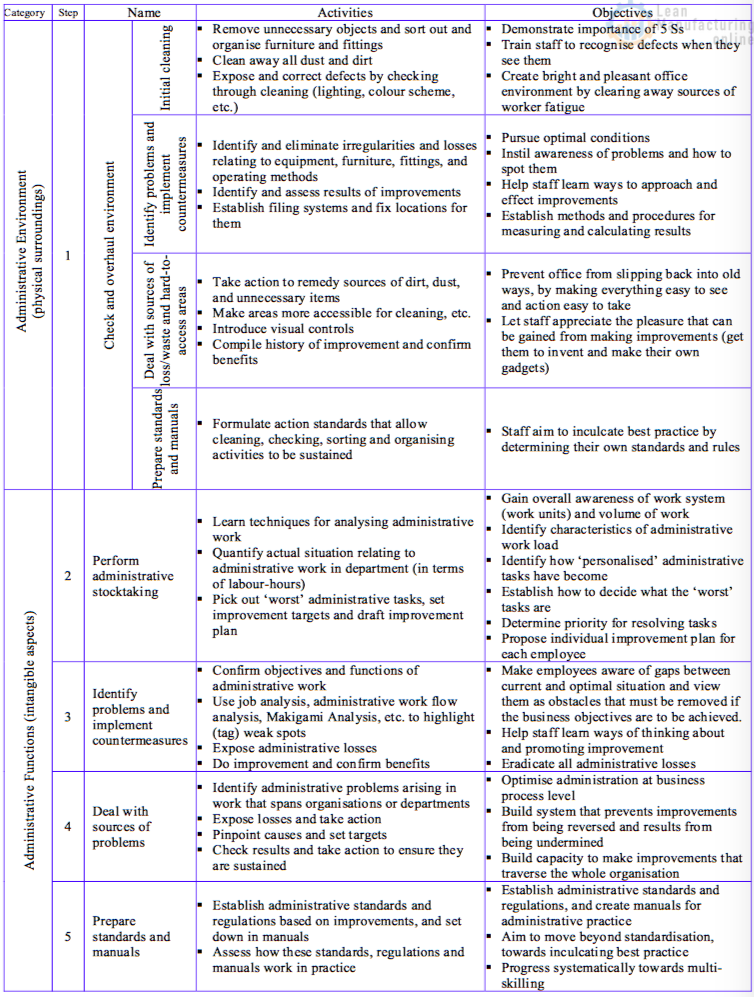

Figure 10.4 Characteristics and Potential Problems of Administrative Work
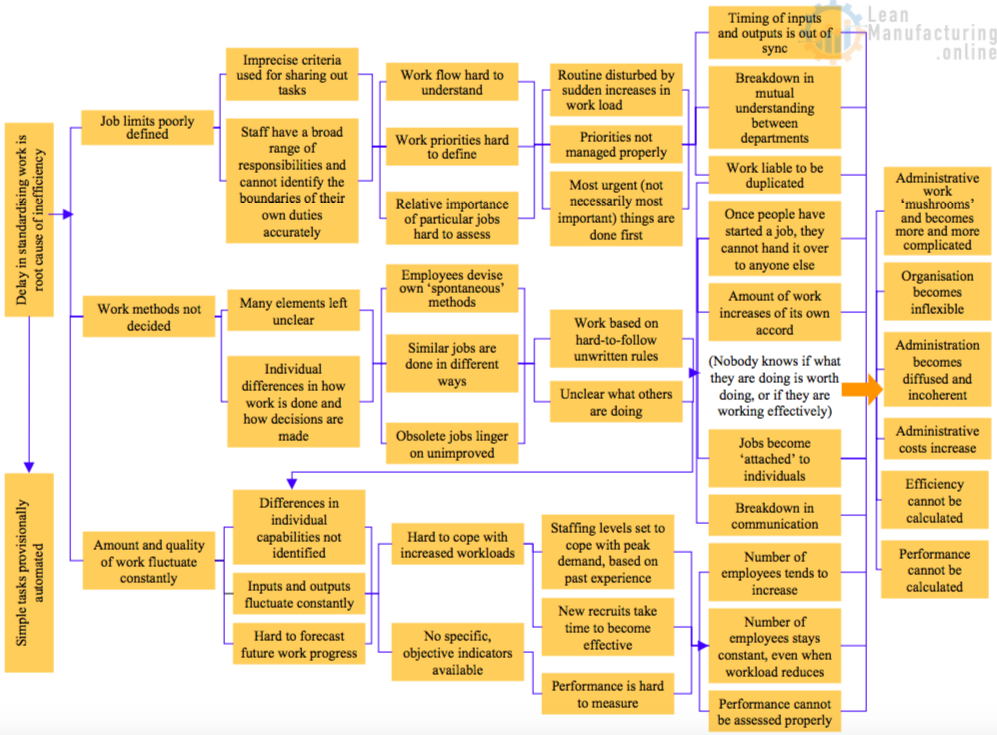
(4) How Autonomous Maintenance differs from Focused Improvement in administrative and support departments
In administrative departments, Autonomous Maintenance and Focused Improvement are fundamentally different. They might appear similar when viewed simply in terms of their results, but the processes and objectives involved are not the same at all (see Figure 10.5).
Administrative Focused Improvement begins with an analysis of the status quo, based on which specific projects and issues are identified and relevant targets are established. Once a target has been reached, that particular activity comes to an end. In administrative Autonomous Maintenance, on the other hand, we do not set out in a particular direction or specific priorities in mind. Rather, our activities are aimed at rooting out all irregularities (including both those that have actually been found to cause problems and those that are theoretically a problem because they represent a divergence from the optimal), using the checking-through-cleaning approach. These irregularities are reversed or corrected, and the resulting procedures are then standardized.
Administrative Autonomous Maintenance, therefore, does not focus simply on finding particular problems and solving them to achieve defined targets, but rather its purpose is to identify and deal with every irregularity or imperfection that can be envisaged. Regardless of whether or not these irregularities can actually be rectified, the process of rooting them all out helps to change the way employees see things and greatly improves their administrative skills. In non-production departments, therefore, the objectives of Autonomous Maintenance are to eradicate all irregularities and losses, standardized administrative procedures, and ultimately create a corps of first-rate administrators.
Figure 10.5 How Autonomous Maintenance differs from Focused Improvement in Administrative and Support Departments
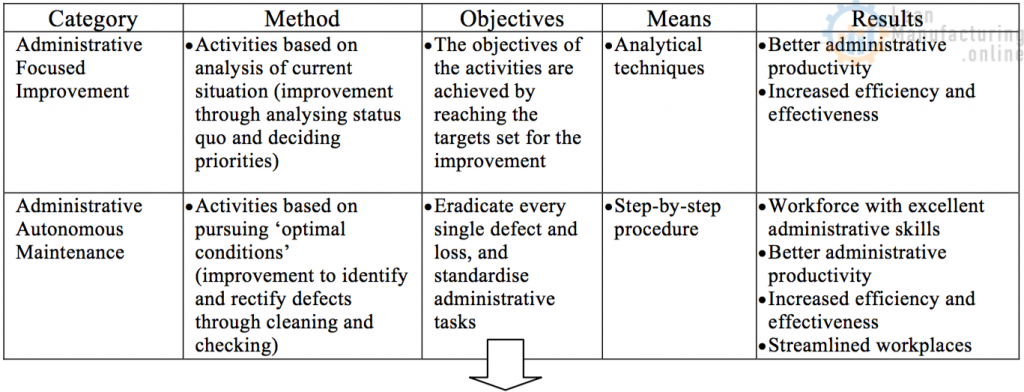
*Focused Improvement: Helps to achieve administrative efficiency targets
*Autonomous Maintenance: Aims to create workforce of excellent administrators, through standardisation of administrative tasks
The difference between ‘Administration’ and ‘Core Work’ in administrative and support departments
‘Administration’
- means job inputs – information processing functions, such as reading, writing, and calculating
- is expected to generate efficient inputs
- relates to third-level or fourth-level work units (WU)‘Core Work’
- means job outputs – business functions (e.g. achieving target purchasing costs, and always purchasing exactly what is needed)
- is expected to generate profitable outputs
- relates to fifth-level or sixth-level work units (WU)
Figure 10.6 Typical Structure of Work Units
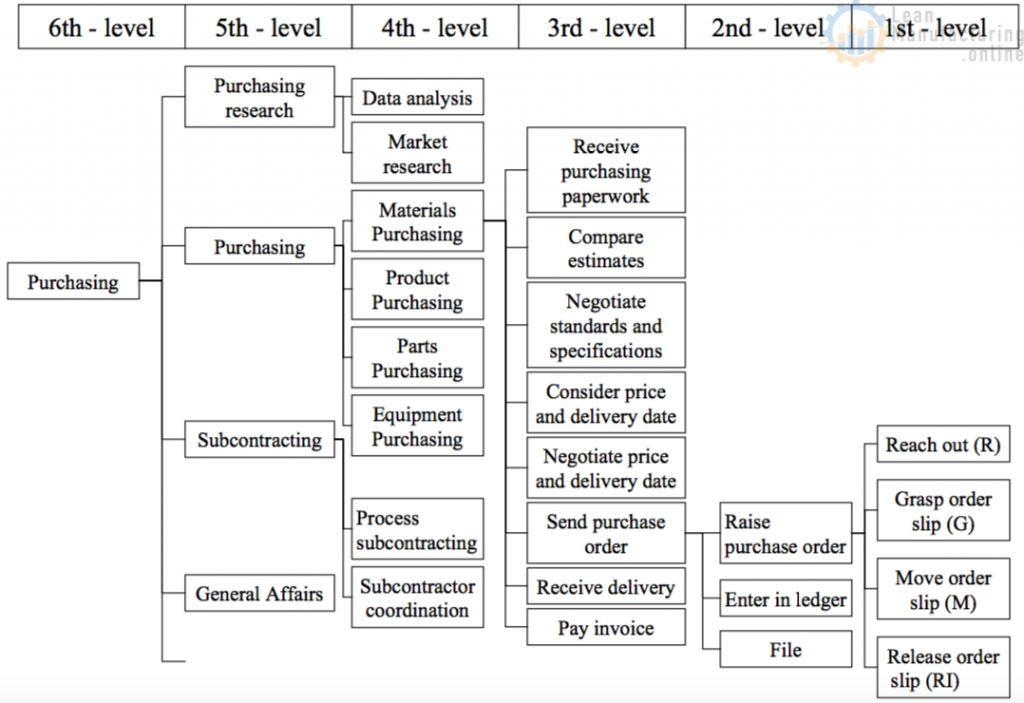
(5) Tackling the administrative environment (physical surroundings)
You cannot get on with your work because the photocopier has jammed. Or your computer has brought up an error message and crashed, and you do not know how to fix it. Right in the middle of an administrative task, your feet feel cold and you cannot concentrate on the job at hand. Perhaps the lighting is badly positioned or dim, so you do not get the right light on your work and end up with tired eyes and stiff shoulders. The stationery cupboard is chock-full, but out of the item you actually want. No-one knows where the fire extinguishers are because they are hidden behind desks and cabinets. What is more, the pool cars are mistreated, no-one ever checks them or changes the oil, and they are always breaking down. People even leave cans, bottles, and other rubbish lying around in them – embarrassing if you have to give a ride to a customer! And the emergency power supply for the computers does not work when needed, so you lose all your data.
Administrative departments often have all sorts of latent ‘hardware-related’ problems like these, which are obvious to everyone, but they carry on without trying to rectify the situation in any way. Solving problems of this kind requires Autonomous Maintenance activities aimed at hardware aspects of the administrative department, such as office equipment, furniture, and fittings, (including filing systems), and so on. Teams should be set up to work towards a stress-free office environment in which employees can concentrate fully on their jobs in relaxed and comfortable surroundings. The company must promote improvements in its organization and a working culture that encourages the development of staff with top-rate administrative skills – people who can spot abnormalities when they see them and resolve problems on their own initiative.
If activities like these, aimed at improving the ‘hard’, or tangible, side of things, engender the right organization and culture, in which people can spot abnormalities or problems and deal with them promptly and effectively, then this will also give a great impetus to activities on the ‘soft’, or intangible, side, aimed at resolving work-related problems and achieving skill-related goals. This means that no corners can be cut – the activities should be implemented thoroughly and precisely, down to the last detail.

( Ideally, filing should be tackled along with other hardware issues in Step 1)
Figure 10.8 Hints for Creating a Paperless Office
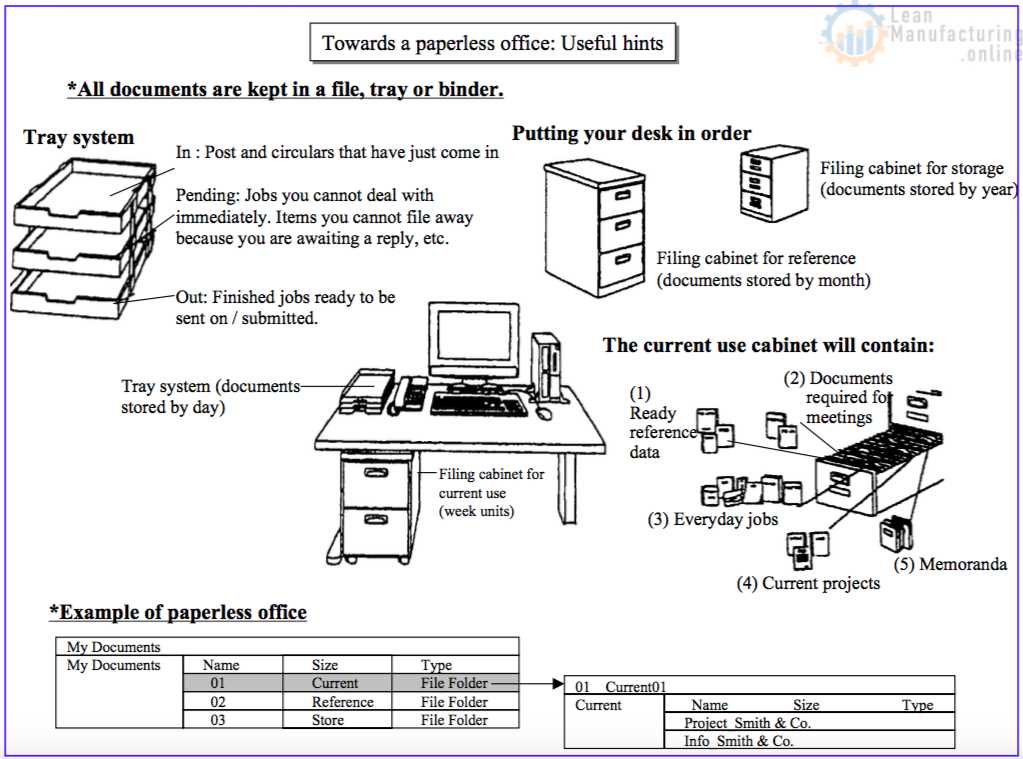
(6) Tackling the administrative functions (the intangible aspects)
Losses may arise in the administrative functions or procedures employed to get the core work done, or the way that administrative tools are used. All of these must therefore be carefully reviewed, the losses must be eradicated, and the basic conditions must be sustained. The ‘7 Big Administrative Losses’ impairing administrative efficiency can be divided broadly into time losses, quality losses, and distribution losses, and it is important to achieve a level of standardization that excludes the possibility of any such losses occurring.
1 Time losses (losses in processing information)
- Various administrative tasks are required at the end of each month, and if these are not done on time, and the relevant reports are handed in late, then this will hold up the important managerial and business decisions that have to be made. These losses can arise in many places – in the time taken to find, process, and check the required information, or in the actual process itself.
- In an office that does not have a proper filing system, a lot of time will be wasted in filing and archiving, or in finding documents and data and extracting the necessary information. In a situation like this, it is very difficult to process information quickly and efficiently.
2 Quality losses (losses due to inaccurate information)
- Memoranda and reports may contain mistakes or omissions or be worded vaguely and confusingly. This means that they have to be rewritten, or the reader has to make inquiries, which creates time losses.
- If the method of compiling reports and data, and the content required (e.g. level of detail, the scope of information) is inappropriate, or if the information is not accurate or up-to-date, then a simple rewrite may not be enough to fix the problem.
3 Distribution losses (losses inflow or timing of information)
- When documents are left in heaps on desks and other surfaces, the workspace becomes cramped and the documents have to be shifted around continually, not only wasting time and effort but also causing stress.
- If we leave unnecessary documents lying around, we cannot make effective use of our space and costs will increase. Also, work-in-progress will tend to pile up, causing delays and blockages in the flow of information and preventing the core work and administrative functions from advancing smoothly.
By eradicating all losses of this kind, we can not only improve individual efficiency and internal departmental efficiency in administrative work but also ensure that cross-departmental tasks are carried out seamlessly and at a high level of productivity. Based on these solid foundations, we can then build a system that allows the information needed for our business activities to be supplied to the right place at the right time every time.
To achieve this, we must promote the optimization and standardization of administrative tasks through Autonomous Maintenance activities aimed at administrative functions. In the process of eradicating administrative losses, we should also be looking to achieve a multi-skilled workforce trained to have excellent administrative capabilities. This will help to create an office system which is easy and pleasant to work in, and which allows people to take time off when it is due to them.

(7) Tips for tackling the administrative functions (the intangible aspect)
Here, the aims are to standardize administrative tasks after eradicating all losses, to correct deficiencies and improve the quality of the administrative functions, and to build a workforce with first-rate office skills (i.e. highly motivated staff who are creative and have the capacity to acquire special skills and get the job done). Activities focused on administrative work and filing are a very important part of this. Ideally, filing should be tackled in Step 1.
(Tips)
- Clarify the administrative structure and carry out an analysis of the manpower required at the administrative level (third and fourth-level work units).
- Identify the worst administrative tasks (the ones that take up the most labor hours), pinpoint the problems with these, and find countermeasures.
- Detecting (tagging) problems make administrative tasks visible. Do a Makigami (paper roll) Analysis using all the slips, chits, vouchers, memos, and other documents currently in use, so that everyone can visualize the workflow. Enlist the help of people not directly involved in the process to compare the current situation with how things really ought to be, to reveal any problems, doubts, or other issues.
- When administrative problems arise, their causes are not isolated to the processing methods used in a particular department. They may also occur because rules in other departments, or interdepartmental rules, are not being followed, and therefore action must be taken straight away to deal with the causes of these problems.
- Although we must standardize administrative tasks once we have eliminated the imperfections, we cannot stop there. We have to instill routine good practice, so that staff automatically do their jobs the right way.
Figure 10.10 Tackling the Administrative Functions
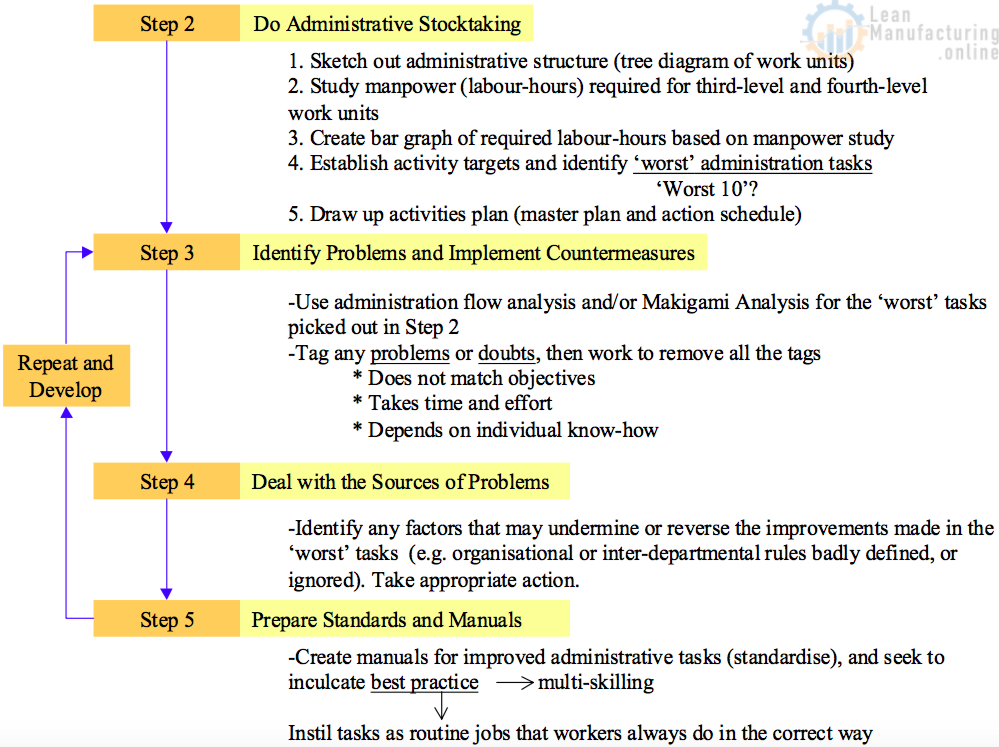
2.2 Improving Administrative Efficiency through Makigami (Paper Roll) Analysis
(1) What is the Makigami Analysis?
- Administrative tasks are usually hard to identify. The Makigami method makes these tasks clearly visible by taking the actual forms, slips, and other documents used in administration work and sticking them on a long roll of paper, to illustrate the flow of work.
- Using the paper roll, anyone, from the person directly responsible to managers and staff from other relevant departments, can tell at a glance what is going on. This helps them to identify problems and suggest improvements.
Makigami Analysis is an improvement tool for raising efficiency in administrative tasks. It embodies the down-to-earth, nuts-and-bolts approach that is the central philosophy of TPM, and its basic premise is to make administrative work seen and understood.
Translator’s Note: ‘Makigami’, which means ‘rolled-up paper’, is compounded from the Japanese words ‘maki’ (rolling up) and ‘kami’ (paper).
(2) Advantages of Makigami Analysis
The actual objects (i.e. forms) used in the administrative work processes are stuck to a roll of paper, in sequence with the workflow. This makes it a highly graphic improvement tool with the following advantages:
- Even outsiders can understand it easily, so it is highly suitable for general display.
- Issues can be examined based on a common understanding of the situation, with relevant departments and staff members fully involved.
- The opinions of disinterested parties can also be incorporated, to help generate really original improvement ideas.
(3) Definition of Makigami Analysis
Makigami Analysis involves a series of improvement activities carried out by internal department staff and members of other relevant departments. They all meet together to:
- Understand the workflow using the paper roll as a tool, to raise administrative efficiency and strengthen administrative functions (both internal and interdepartmental);
- Expose problems and discuss possible improvements and solutions;
- Implement improvements. The results of these improvements serve to increase administrative efficiency and strengthen administrative functions both within each department and across different departments.
(4) Key points of Makigami Analysis
- ‘Reproduce’ the administrative work by using the actual forms, memos, and data used.
- Spot where to make improvements and come up with concrete improvement proposals, always keeping your eyes peeled for WUS (waste, unevenness, and strain) and the 7 Big Administrative Losses.
- Bear in mind at all times that the aim is to improve both intra- and inter-departmental efficiency, and strengthen administrative functions. Implement improvements that are based on the facts.
- Do not stick just to intra-departmental improvements. Rather, look to raise efficiency in a way that contributes to ‘raising overall effectiveness’ as defined in TPM.
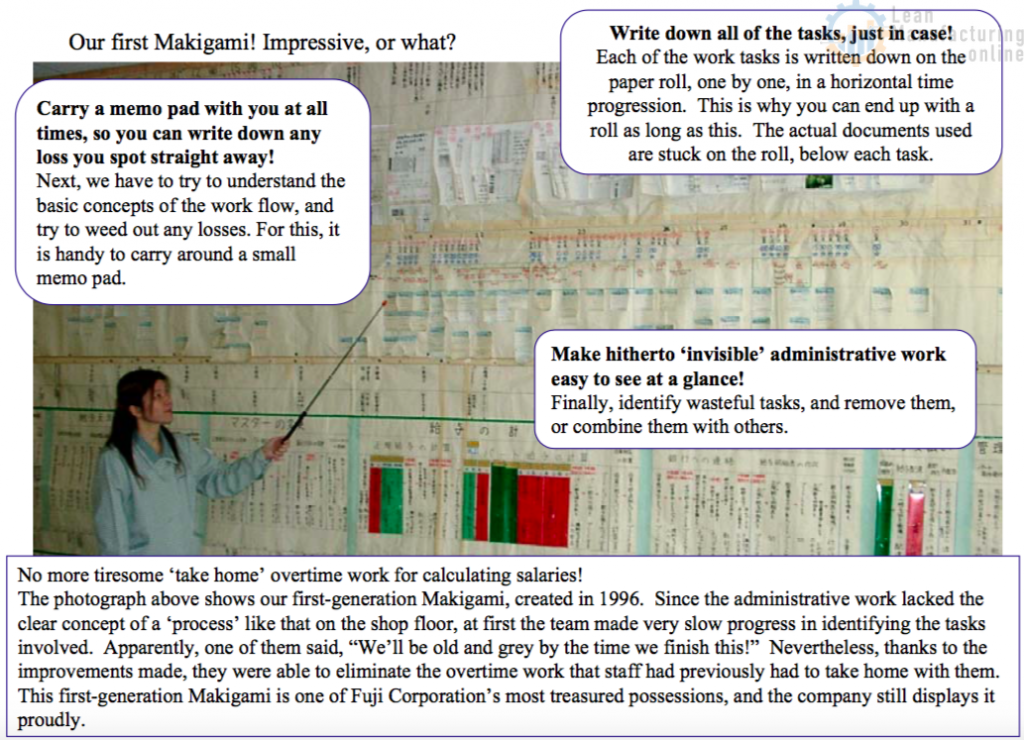
Chapter 10. TPM in Administrative and Support Departments. Part 2









